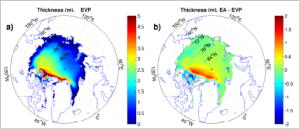Impact of a new anisotropic rheology on the Arctic sea ice
Michael Tsamados, Daniel Feltham
We have implement into the Los Alamos CICE sea ice model an anisotropic rheology [Wilchinsky and Feltham, 2006] that explicitly accounts for the local anisotropy of the sea ice cover. This is in contrast to most current models of sea ice included in Global Circulation Models that use a variant of the isotropic, visco-plastic rheology. The model is simple, it contains one extra variable, the local structure tensor A, that quantifies the degree of anisotropy of the sea ice, and two parameters that set the time scale of the reorientation and evolution of this local tensor. We have run a stand-alone version of the anisotropic version of the CICE model, which demonstrates that including anisotropic sea ice mechanics has a significant impact on sea ice volume, thickness distribution, motion and deformation (e.g., see Figure). Under realistic atmospheric and oceanic forcing, the sea ice quickly becomes highly anisotropic over large length scales, as is observed from satellite imagery.

Figure: The 1990-2007 climatological September mean ice thickness from the standard CICE model with isotropic, EVP rheology (a), and the difference in thickness using the anisotropic, EA rheology. Thickness scale is in metres. Note the different colour scales.
Reference:
Wilchinsky, AV, and DL Feltham, 2006. Modelling the rheology of sea ice as a collection of diamond-shaped floes. J. Non-Newtonian Fluid Mechanics, 138, 22-32.
